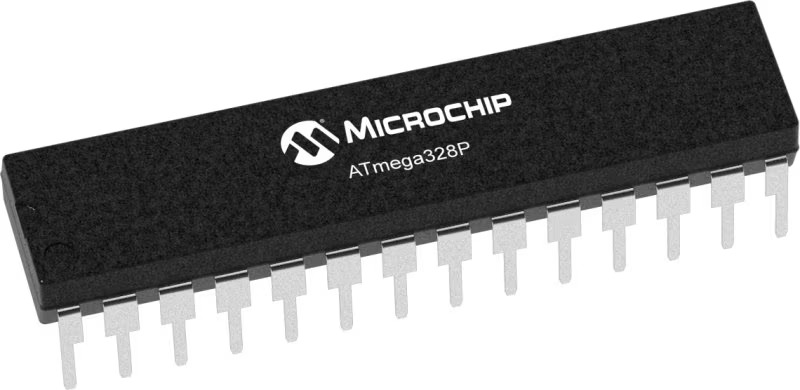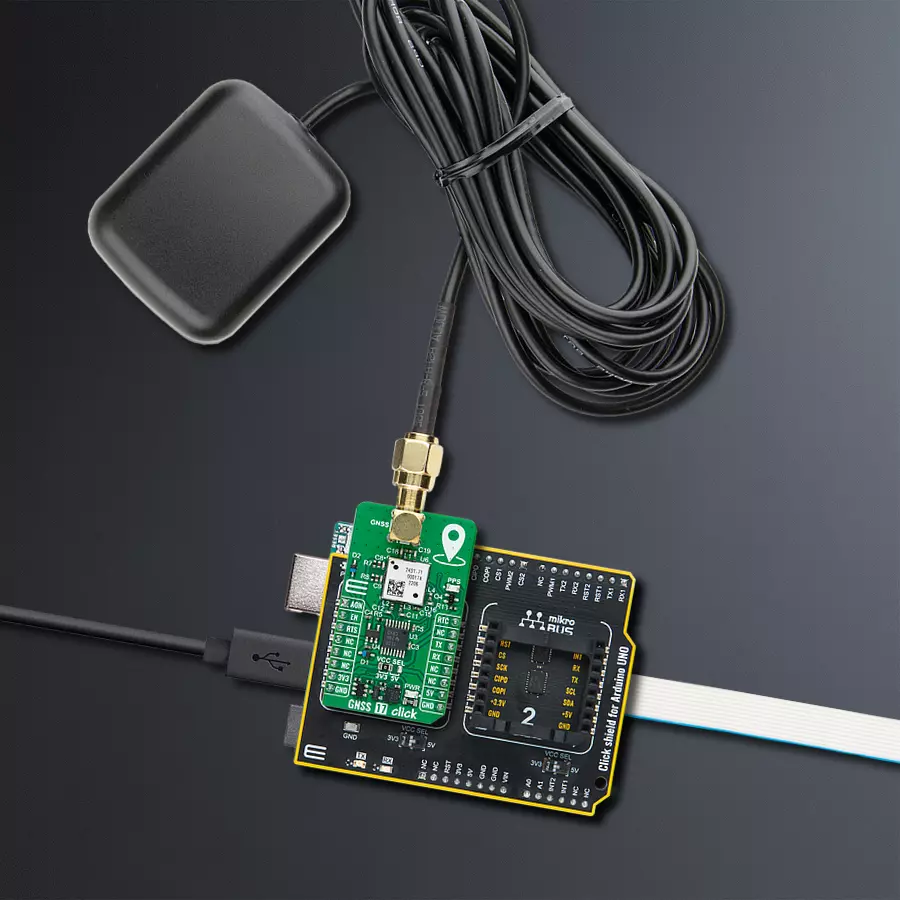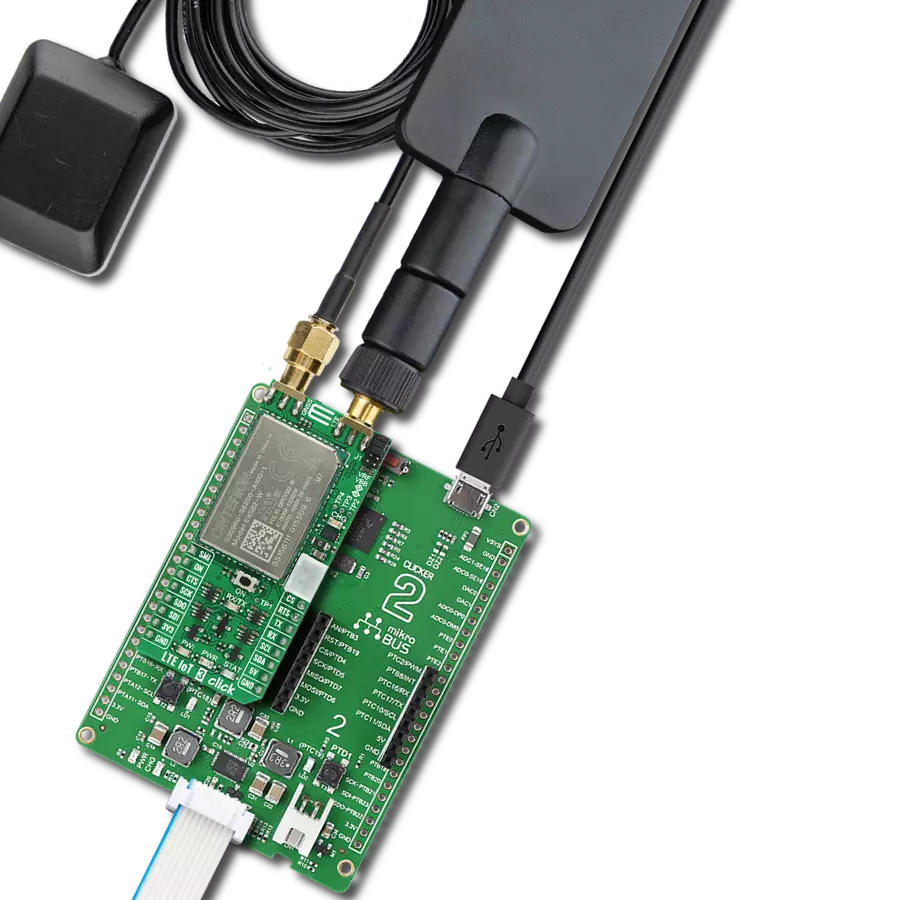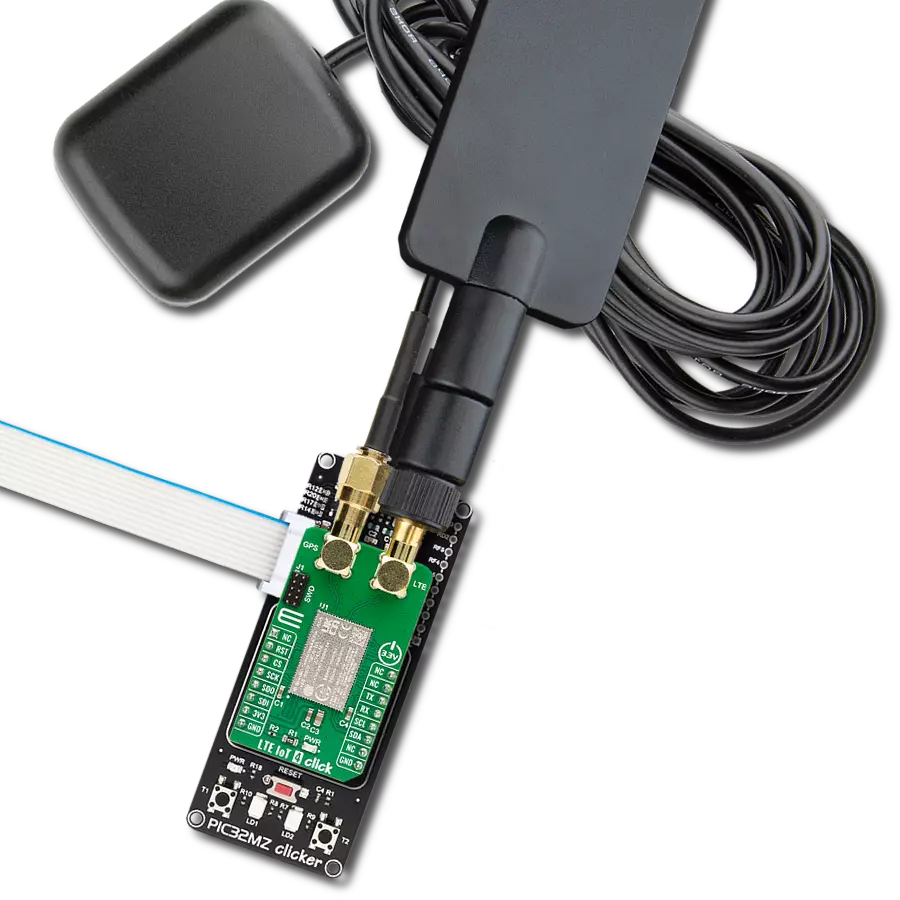同时跟踪GPS、GLONASS、Galileo、BeiDou和QZSS卫星,以提高定位精度,尤其是在城市环境中
A
A
硬件概览
它是如何工作的?
GNSS 17 Click 基于 Antenova 的 M20071,这是一个集成全功能 GNSS 接收器模块。该模块包括 MediaTek AG3335MN 闪存芯片,能够同时跟踪多个 GNSS 星座,如 GPS、GLONASS、GALILEO、BEIDOU 和 QZSS。M20071 的高级多路径算法提高了定位精度,特别是在密集的城市环境中。此外,板载 LNA 确保在弱信号场景下表现出色,非常适合可穿戴设备。此 Click board™ 适用于多种应用,包括便携设备、资产跟踪、个人安全、运动电子和导航系统,提供可靠且精确的定位服务。M20071 还具有几个显著特性,增强了此板的功能。EPO(扩展预测轨道)快速修复功能允许模块使用长达 30 天的轨道预测,实现即时修复解决方案。EASY(自生成轨道预测)功能通过提供长达 3 天的 GPS 轨道预测,无需互联网连接或主处理器上的软件,加速 TTFF(首次定位时间)性能。此外,AIC(主动干扰消除)功能提供有效的窄带干扰消除,确保即使在挑战性环境中也能可靠和准确的 GNSS 性能。M20071 还提供三种
节能模式:关闭、RTC 和周期。在关闭模式下,通过 mikroBUS™ 插座的 EN 引脚控制,模块仅保持电源管理逻辑激活,当 EN 引脚处于低逻辑状态时,所有其他逻辑电路断电。RTC 模式,通过 mikroBUS™ 插座的 RTC 引脚管理,是一种低功耗状态,关闭系统核心。此模式下模块不能发送命令或提供与位置相关的信息,但它会将导航数据保存到 RTC-RAM。唤醒后,模块使用这些保存的数据快速重新获取位置修复。周期模式是一种用户可配置状态,模块在运行和睡眠之间交替,减少电流消耗,同时保持更新的数据。这种灵活性允许用户根据特定的功耗和性能需求调整模块的操作。M20071 模块和主机 MCU 通过 UART 接口进行通信,使用标准 UART RX 和 TX 引脚。默认通信速度设置为 115200bps,确保高效的数据交换。除了 UART TX 和 RX 引脚外,板上还使用 RTS 引脚与主机 MCU 进行握手,以防止丢失命令。此外,GNSS 17 Click 包括一个绿色 PPS LED 指示灯,每秒从 M20071 发出一个同步脉冲信号。此脉冲
信号的默认宽度为 100 ms,但可以配置在 50 ms 到 999 ms 之间。PPS 功能默认启用,一旦达到 3D 修复,模块将输出 PPS 信号。M20071 不需要特定的上电顺序,但其系统核心需要 1.8V 电压才能正常工作。为实现这一点,两个小型 AP2112 LDO 稳压器从 mikroBUS™ 电源轨提供必要的 1.8V 电压,为 M20071 及其 GNSS 天线供电。除了 mikroBUS™ 电源轨外,此板还支持从板背面附加的纽扣电池提供备用电源。负责 GNSS 天线供电的稳压器可以通过 mikroBUS™ 插座的 AON 引脚激活。此 Click board™ 可以通过 VCC SEL 跳线选择使用 3.3V 或 5V 逻辑电压水平。由于 M20071 模块在 1.8V 下工作,使用逻辑电平转换器 TXB0106 以实现正确操作和精确的信号电平转换。因此,3.3V 和 5V 兼容的 MCU 都可以正确使用通信线路。此外,这款 Click board™ 配备了包含易用功能的库和示例代码,可作为进一步开发的参考。
功能概述
开发板
Arduino UNO 是围绕 ATmega328P 芯片构建的多功能微控制器板。它为各种项目提供了广泛的连接选项,具有 14 个数字输入/输出引脚,其中六个支持 PWM 输出,以及六个模拟输入。其核心组件包括一个 16MHz 的陶瓷谐振器、一个 USB 连接器、一个电
源插孔、一个 ICSP 头和一个复位按钮,提供了为板 子供电和编程所需的一切。UNO 可以通过 USB 连接到计算机,也可以通过 AC-to-DC 适配器或电池供电。作为第一个 USB Arduino 板,它成为 Arduino 平台的基准,"Uno" 符号化其作为系列首款产品的地
位。这个名称选择,意为意大利语中的 "一",是为了 纪念 Arduino Software(IDE)1.0 的推出。最初与 Arduino Software(IDE)版本1.0 同时推出,Uno 自此成为后续 Arduino 发布的基础模型,体现了该平台的演进。
微控制器概述
MCU卡片 / MCU

建筑
AVR
MCU 内存 (KB)
32
硅供应商
Microchip
引脚数
28
RAM (字节)
2048
你完善了我!
配件
Click Shield for Arduino UNO 具有两个专有的 mikroBUS™ 插座,使所有 Click board™ 设备能够轻松与 Arduino UNO 板进行接口连接。Arduino UNO 是一款基于 ATmega328P 的微控制器开发板,为用户提供了一种经济实惠且灵活的方式来测试新概念并构建基于 ATmega328P 微控制器的原型系统,结合了性能、功耗和功能的多种配置选择。Arduino UNO 具有 14 个数字输入/输出引脚(其中 6 个可用作 PWM 输出)、6 个模拟输入、16 MHz 陶瓷谐振器(CSTCE16M0V53-R0)、USB 接口、电源插座、ICSP 头和复位按钮。大多数 ATmega328P 微控制器的引脚都连接到开发板左右两侧的 IO 引脚,然后再连接到两个 mikroBUS™ 插座。这款 Click Shield 还配备了多个开关,可执行各种功能,例如选择 mikroBUS™ 插座上模拟信号的逻辑电平,以及选择 mikroBUS™ 插座本身的逻辑电压电平。此外,用户还可以通过现有的双向电平转换电压转换器使用任何 Click board™,无论 Click board™ 运行在 3.3V 还是 5V 逻辑电压电平。一旦将 Arduino UNO 板与 Click Shield for Arduino UNO 连接,用户即可访问数百种 Click board™,并兼容 3.3V 或 5V 逻辑电压电平的设备。
主动 GPS 天线旨在增强您的 GPS 和 GNSS Click 板™ 的性能。这款外置天线结构坚固,适用于各种天气条件。凭借 1575.42MHz 的频率范围和 50Ohm 的阻抗,它确保了可靠的信号接收。天线在较宽的角度范围内提供大于 -4dBic 的增益,确保超过 75% 的覆盖率。± 5MHz 的带宽进一步保证了精确的数据采集。天线采用右旋圆极化 (RHCP),提供稳定的信号接收。其紧凑的尺寸为 48.5×39×15mm,配有 2 米长的电缆,安装方便。磁性天线类型与 SMA 公连接器确保了安全便捷的连接。如果您需要为定位设备提供可靠的外置天线,我们的主动 GPS 天线是完美的解决方案。

使用的MCU引脚
mikroBUS™映射器
“仔细看看!”
Click board™ 原理图

一步一步来
项目组装
软件支持
库描述
该库包含 NAME Click 驱动程序的 API。
关键功能:
gnss17_generic_read- 此函数通过使用UART串行接口读取所需数量的数据字节。gnss17_parse_gga- 此函数从读取的响应缓冲区解析GGA数据。gnss17_reset_device- 此函数通过切换EN和AON引脚来重置设备。
开源
代码示例
完整的应用程序代码和一个现成的项目可以通过NECTO Studio包管理器直接安装到NECTO Studio。 应用程序代码也可以在MIKROE的GitHub账户中找到。
/*!
* @file main.c
* @brief GNSS 17 Click Example.
*
* # Description
* This example demonstrates the use of GNSS 17 Click by reading and displaying
* the GNSS coordinates.
*
* The demo application is composed of two sections :
*
* ## Application Init
* Initializes the driver and resets the Click board.
*
* ## Application Task
* Reads the received data, parses the NMEA GGA info from it, and once it receives
* the position fix it will start displaying the coordinates on the USB UART.
*
* ## Additional Function
* - static void gnss17_clear_app_buf ( void )
* - static void gnss17_log_app_buf ( void )
* - static err_t gnss17_process ( gnss17_t *ctx )
* - static void gnss17_parser_application ( uint8_t *rsp )
*
* @author Stefan Filipovic
*
*/
#include "board.h"
#include "log.h"
#include "gnss17.h"
// Application buffer size
#define APP_BUFFER_SIZE 500
#define PROCESS_BUFFER_SIZE 200
static gnss17_t gnss17;
static log_t logger;
static uint8_t app_buf[ APP_BUFFER_SIZE ] = { 0 };
static int32_t app_buf_len = 0;
/**
* @brief GNSS 17 clearing application buffer.
* @details This function clears memory of application buffer and reset its length.
* @note None.
*/
static void gnss17_clear_app_buf ( void );
/**
* @brief GNSS 17 log application buffer.
* @details This function logs data from application buffer to USB UART.
* @note None.
*/
static void gnss17_log_app_buf ( void );
/**
* @brief GNSS 17 data reading function.
* @details This function reads data from device and concatenates data to application buffer.
* @param[in] ctx : Click context object.
* See #gnss17_t object definition for detailed explanation.
* @return @li @c 0 - Read some data.
* @li @c -1 - Nothing is read.
* See #err_t definition for detailed explanation.
* @note None.
*/
static err_t gnss17_process ( gnss17_t *ctx );
/**
* @brief GNSS 17 parser application.
* @param[in] rsp Response buffer.
* @details This function logs GNSS data on the USB UART.
* @return None.
* @note None.
*/
static void gnss17_parser_application ( uint8_t *rsp );
void application_init ( void )
{
log_cfg_t log_cfg; /**< Logger config object. */
gnss17_cfg_t gnss17_cfg; /**< Click config object. */
/**
* Logger initialization.
* Default baud rate: 115200
* Default log level: LOG_LEVEL_DEBUG
* @note If USB_UART_RX and USB_UART_TX
* are defined as HAL_PIN_NC, you will
* need to define them manually for log to work.
* See @b LOG_MAP_USB_UART macro definition for detailed explanation.
*/
LOG_MAP_USB_UART( log_cfg );
log_init( &logger, &log_cfg );
log_info( &logger, " Application Init " );
// Click initialization.
gnss17_cfg_setup( &gnss17_cfg );
GNSS17_MAP_MIKROBUS( gnss17_cfg, MIKROBUS_1 );
if ( UART_ERROR == gnss17_init( &gnss17, &gnss17_cfg ) )
{
log_error( &logger, " Communication init." );
for ( ; ; );
}
log_info( &logger, " Application Task " );
}
void application_task ( void )
{
if ( GNSS17_OK == gnss17_process( &gnss17 ) )
{
if ( app_buf_len > ( sizeof ( GNSS17_RSP_GGA ) + GNSS17_GGA_ELEMENT_SIZE ) )
{
gnss17_parser_application( app_buf );
}
}
}
int main ( void )
{
/* Do not remove this line or clock might not be set correctly. */
#ifdef PREINIT_SUPPORTED
preinit();
#endif
application_init( );
for ( ; ; )
{
application_task( );
}
return 0;
}
static void gnss17_clear_app_buf ( void )
{
memset( app_buf, 0, app_buf_len );
app_buf_len = 0;
}
static void gnss17_log_app_buf ( void )
{
for ( int32_t buf_cnt = 0; buf_cnt < app_buf_len; buf_cnt++ )
{
log_printf( &logger, "%c", app_buf[ buf_cnt ] );
}
}
static err_t gnss17_process ( gnss17_t *ctx )
{
uint8_t rx_buf[ PROCESS_BUFFER_SIZE ] = { 0 };
int32_t overflow_bytes = 0;
int32_t rx_cnt = 0;
int32_t rx_size = gnss17_generic_read( ctx, rx_buf, PROCESS_BUFFER_SIZE );
if ( ( rx_size > 0 ) && ( rx_size <= APP_BUFFER_SIZE ) )
{
if ( ( app_buf_len + rx_size ) > APP_BUFFER_SIZE )
{
overflow_bytes = ( app_buf_len + rx_size ) - APP_BUFFER_SIZE;
app_buf_len = APP_BUFFER_SIZE - rx_size;
memmove ( app_buf, &app_buf[ overflow_bytes ], app_buf_len );
memset ( &app_buf[ app_buf_len ], 0, overflow_bytes );
}
for ( rx_cnt = 0; rx_cnt < rx_size; rx_cnt++ )
{
if ( rx_buf[ rx_cnt ] )
{
app_buf[ app_buf_len++ ] = rx_buf[ rx_cnt ];
}
}
return GNSS17_OK;
}
return GNSS17_ERROR;
}
static void gnss17_parser_application ( uint8_t *rsp )
{
uint8_t element_buf[ 200 ] = { 0 };
if ( GNSS17_OK == gnss17_parse_gga( rsp, GNSS17_GGA_LATITUDE, element_buf ) )
{
static uint8_t wait_for_fix_cnt = 0;
if ( strlen( element_buf ) > 0 )
{
log_printf( &logger, "\r\n Latitude: %.2s degrees, %s minutes \r\n", element_buf, &element_buf[ 2 ] );
memset( element_buf, 0, sizeof( element_buf ) );
gnss17_parse_gga( rsp, GNSS17_GGA_LONGITUDE, element_buf );
log_printf( &logger, " Longitude: %.3s degrees, %s minutes \r\n", element_buf, &element_buf[ 3 ] );
memset( element_buf, 0, sizeof( element_buf ) );
gnss17_parse_gga( rsp, GNSS17_GGA_ALTITUDE, element_buf );
log_printf( &logger, " Altitude: %s m \r\n", element_buf );
wait_for_fix_cnt = 0;
}
else
{
if ( wait_for_fix_cnt % 5 == 0 )
{
log_printf( &logger, " Waiting for the position fix...\r\n\n" );
wait_for_fix_cnt = 0;
}
wait_for_fix_cnt++;
}
gnss17_clear_app_buf( );
}
}
// ------------------------------------------------------------------------ END
额外支持
资源
类别:GPS/GNSS


































